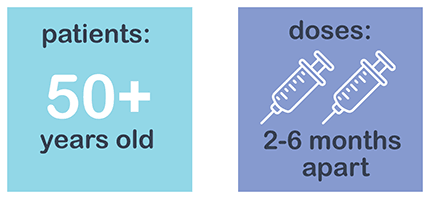Shingles Vaccine Fact Sheet for Healthcare Providers
CDC recommends the shingles vaccine (Shingrix) for adults 50 and older

Who should get Shingrix
Give Shingrix to immunocompetent adults 50 years and older, including those who
- had shingles in the past
- received Zostavax® at least 8 weeks prior
- have health conditions, such as chronic renal failure, diabetes mellitus, rheumatoid arthritis, or chronic pulmonary disease
- are receiving other vaccines, such as influenza and pneumococcal vaccines, at the same visit
- are taking low-dose immunosuppressive therapy
Who should not get Shingrix
You should not give Shingrix to a patient who has ever had a severe allergic reaction, such as anaphylaxis, to a component of this vaccine, or after a dose of Shingrix. Consider delaying vaccination if your patient is pregnant, lactating, or experiencing an acute episode of shingles.
About Shingrix
Shingrix is a new adjuvanted, non-live recombinant shingles vaccine. Two doses of Shingrix provides more than 90% protection against shingles and postherpetic neuralgia (PHN), the most common complication of shingles.

Administering and storing Shingrix
- Adults 50 years and older should receive 2 doses of Shingrix. Give the second dose 2 to 6 months after the first.
- Administer Shingrix intramuscularly in the deltoid region of the upper arm with a 1- to 1.5-inch needle.
- Both vials of Shingrix must be refrigerated at a temperature of 36-46° F. Do not use if exposed to temperatures below 36° F.
Reconstitution
- Prepare Shingrix by reconstituting the antigen component with the adjuvant suspension component.
- Either administer it immediately, or store it in the refrigerator and use it within 6 hours of reconstitution. Otherwise, discard it.
Cost and insurance
Shingrix is now covered by most health insurance plans. Tell your patients to contact their health insurance providers ahead of time to see if they will cover the vaccine.
Report adverse reactions to Shingrix
Report clinically important adverse events that occur after vaccination, even if you are not sure whether the vaccine caused the adverse event, to the Vaccine Adverse Events Reporting System (vaers.hhs.gov).
Counseling patients about Shingrix
Know the benefits and side effects of Shingrix so you’re prepared to talk with your patients before administering the vaccine.
What to tell patients about Shingrix benefits:
- You can protect yourself against shingles. Shingles is a very painful disease, and your risk of getting it increases as you age. Also, you are more likely to have severe, long-term pain if you get shingles when you are older. About 1 out of every 3 people in the United States will develop shingles in their lifetime.
- Shingrix provides strong protection against shingles and long-term pain from the disease. Two doses of Shingrix are more than 90% effective at preventing shingles. So it’s very important that you get this vaccine.
What to tell patients about Shingrix side effects:
- Most people have a sore arm after they get Shingrix. Many people have redness and swelling on their arm spanning several inches where they got the shot. Many people also felt tired or experienced muscle pain, a headache, shivering, fever, stomach pain, or nausea. About 1 out of 6 people had symptoms severe enough to prevent them from doing regular activities. You should plan to avoid strenuous activities, such as yardwork or swimming, for a few days after vaccination. Side effects usually go away after 2 to 3 days. Remember that the pain from shingles can last a lifetime, and these side effects should only last a few days.
- If you do have side effects, you may choose to take over-the-counter pain medicine such as ibuprofen or acetaminophen. You can submit a report of your side effects to the Vaccine Adverse Event Reporting System through the website (vaers.hhs.gov).
What to tell patients about dose two:
- You need to come back in 2 to 6 months for your second dose. We can make that appointment now.
- Even if you have side effects from the first dose, it is important to get the second dose to build strong protection against shingles. Your reaction to each dose may be different; just because you have a reaction to the first dose does not mean that you will have a reaction to the second.

